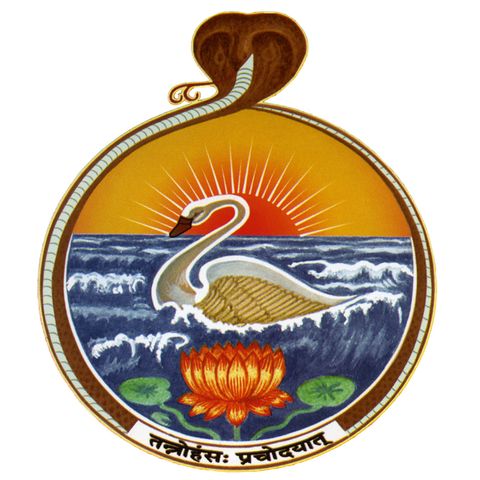Vivekachudamani 12 - Maya – The Great Wonder 2 | Swami Tattwamayananda

Scarica e ascolta ovunque
Scarica i tuoi episodi preferiti e goditi l'ascolto, ovunque tu sia! Iscriviti o accedi ora per ascoltare offline.
Descrizione
Verses: 109-111 This lecture was given by Swami Tattwamayananda at Stanford University on September 8, 2019. The lecture was hosted by the Stanford Hindu Students Association. Class starts with seven...
mostra di piùThis lecture was given by Swami Tattwamayananda at Stanford University on September 8, 2019. The lecture was hosted by the Stanford Hindu Students Association.
Class starts with seven questions from the student, and then bondage is discussed in depth: (1) What is this bondage? (2) How does it come about? (3) How does it exist and what sustains it? (4) How do we come out of it? (5) What is anatman? (6) What is the supreme Atman? (7) How do we differentiate between atman and anatman?
Sthula Sharira, Sukshma Sharira and Karana Sharira are briefly discussed. Sukshma-Sharira has eight units: (1) Five organs of perception (2) Five organs of action (3) Five pranas (4) Five subtle elements (5) Antahkarna – mana, buddhi, chitta, ahamkara (6) Avidya (7) Kama and (8) Karma.
Vedanta’s criteria for “sat” are discussed: (1) It should remain without change in the past, present and future – both time and space. (2) It should stay the same in waking, dream and deep sleep states.
Maya is not “sat”. It is not the Absolute Reality. It changes – therefore, it is relative. Maya is not “asat” either, as it is not Absolutely unreal. It is not a combination of sat and asat either.
Maya is “anadi” (without a beginning), but not “anantha” (it is not eternal). Maya is without a beginning - this is realized only when we go beyond Maya.
Maya is neither different from Brahman, nor non-different nor a combination of difference and non-difference. If Maya were the same as Brahman it can have no end. Then, there is no liberation from bondage. And if Maya were different from Brahman that would lead to duality. When you realize Brahman, what was hitherto perceived as Maya is now perceived as Brahman because then, the Reality is perceived devoid of names and forms, beyond nama and rupa.
A Jeevan-mukta does not see the world of names and forms. He sees the world as Brahman, devoid of name and form.
Maya is neither endowed with parts nor devoid of parts, nor a combination of the two. If it were endowed with parts, it cannot be anadi. If it were devoid of parts, it cannot be the cause of evolution.
All of us experience Maya in our everyday life. It is beyond logical comprehension, cannot be explained in words or cognized with the mind, and is a great wonder.
Maya makes life livable – all higher pursuits in life are because of the unpredictability in life. This unpredictability is an expression of Maya. Maya provides us the opportunity to transcend it, and become spiritually liberated.
Swami Vivekananda provides many examples of how Maya defies human logic. Example of mother’s continued affection towards an ungrateful child is provided.
Maya is neither subjective, nor objective, nor a combination of the two. We understand the relativity of Maya only when we come out of it. Describing Maya when we are within it is impossible.
Gospel of Sri Ramakrishna is a good scripture to understand Maya. It provides many examples of different levels of human existence.
Maya functions at the level of three gunas: Sattva, Rajas and Tamas. As in the snake/rope analogy, the wrong understanding disappears when we realize our true nature. Swami Vivekananda’s story is discussed of how Sri Ramakrishna transmitted spiritual powers to him to help him see beyond Baya.
Maya operates with two powers: Avarana-shakti, which conceals the reality and Vikshepa-shakti, which projects something false.
Maya is a great mystery and efforts to understand it gave us great souls such as Buddha. Buddha made great contributions to human civilization.
Verse 111 and vikshepa shakti is briefly introduced. An example is provided of how mind can project an imaginary world, based on triggers from any of the senses. Even this projection leaves a residual effect on the mental system. This happens because of Rajas-guna.
Maya is composed of two sounds: “Ma”, which negates and “Ya” which is a pronoun and refers to something real.
Regular spiritual practices and reading of authentic scriptures helps the seeker develop spiritual common sense. This common sense helps him restructure his attitude to life as a whole.
Sri Ramakrishna taught spirituality in all forms: non-dualism, dualism and bhakti are some examples. Non-dualism accommodates and transcends all religions.
Informazioni
| Autore | Vedanta Society, San Francisco |
| Organizzazione | Vedanta Society, San Francisco |
| Sito | - |
| Tag |
Copyright 2024 - Spreaker Inc. an iHeartMedia Company

Commenti